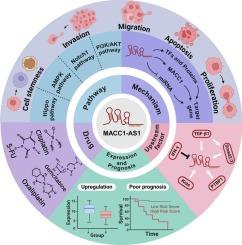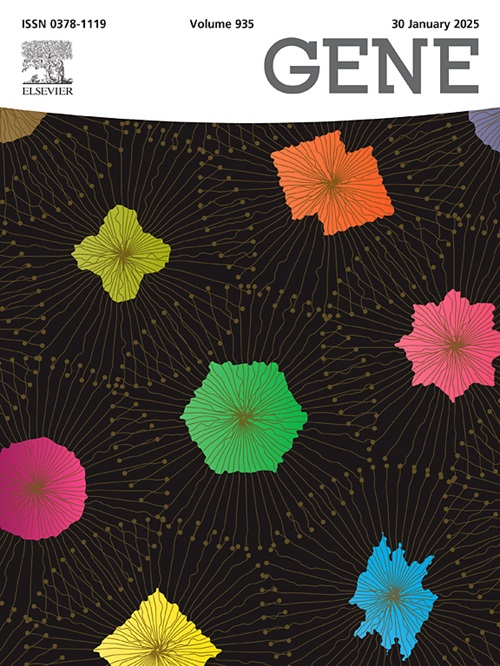全面了解MACC1-AS1:在癌症中的作用和治疗意义。
IF 2.4
3区 生物学
Q2 GENETICS & HEREDITY
引用次数: 0
摘要
长链非编码rna (lncRNAs)是一类长度超过200个核苷酸的非编码转录物,在基因调控和疾病进展中发挥关键作用。其中,位于染色体7p21.1上的MACC1反义RNA 1 (MACC1- as1)以反义方向转录至结肠癌转移相关基因1 (MACC1)。MACC1-AS1在10种癌症中显著过表达,并与不良预后和临床特征相关。MACC1-AS1受上游调节剂如干扰素-γ (IFN-γ)、多嘧啶束结合蛋白1 (PTBP1)、Smad2、转化生长因子-β1 (TGF-β1)和Kras的转录或转录后调控。反过来,MACC1- as1通过三种主要的分子机制影响下游效应物:作为竞争性内源性RNA (ceRNA)调节microRNA (miRNA)-mRNA轴,与MACC1 mRNA结合反义,调节转录因子以及下游蛋白表达。MACC1-AS1参与多种细胞信号通路,包括AMPK、Hippo、PI3K/AKT和Notch1通路。MACC1-AS1调节增殖、凋亡、上皮-间质转化(EMT)、侵袭、迁移和肿瘤干细胞的维持。此外,MACC1-AS1有助于治疗耐药,降低对化疗药物的敏感性,如5-氟尿嘧啶(5-FU)、奥沙利铂、吉西他滨和顺铂,以及对5-氟尿嘧啶和奥沙利铂(FOLFOX)联合方案。本文综述了目前关于MACC1-AS1的知识,并强调了其作为生物标志物和未来转化研究的治疗靶点的潜力。本文章由计算机程序翻译,如有差异,请以英文原文为准。

Comprehensive insights into MACC1-AS1: Role in cancer and therapeutic implications
Long non-coding RNAs (lncRNAs) are a diverse class of non-coding transcripts longer than 200 nucleotides that play critical roles in gene regulation and disease progression. Among them, MACC1 antisense RNA 1 (MACC1-AS1), located on chromosome 7p21.1, is transcribed in antisense orientation to the metastasis-associated in colon cancer-1 (MACC1) gene. MACC1-AS1 is significantly overexpressed in ten types of cancers and is associated with poor prognosis and clinical characteristics. MACC1-AS1 is transcriptionally or post-transcriptionally regulated by upstream modulators such as interferon-γ (IFN-γ), polypyrimidine tract-binding protein 1 (PTBP1), Smad2, transforming growth factor-β1 (TGF-β1), and Kras. In turn, MACC1-AS1 influences downstream effectors through three principal molecular mechanisms: acting as a competitive endogenous RNA (ceRNA) to modulate the microRNA (miRNA)–mRNA axis, binding antisense to MACC1 mRNA, and regulating transcription factors as well as downstream protein expression. MACC1-AS1 participates in multiple cellular signaling pathways, including AMPK, Hippo, PI3K/AKT, and Notch1 pathways. MACC1-AS1 modulates proliferation, apoptosis, epithelial–mesenchymal transition (EMT), invasion, migration, and the maintenance of cancer stemness. Moreover, MACC1-AS1 contributes to therapeutic resistance, conferring reduced sensitivity to chemotherapeutic agents such as 5-fluorouracil (5-FU), oxaliplatin, gemcitabine, and cisplatin, as well as to combination regimens including 5-fluorouracil and oxaliplatin (FOLFOX). This review provides an overview of the current knowledge surrounding MACC1-AS1 and highlights its potential as both a biomarker and a therapeutic target for future translational research.
求助全文
通过发布文献求助,成功后即可免费获取论文全文。
去求助
来源期刊

Gene
生物-遗传学
CiteScore
6.10
自引率
2.90%
发文量
718
审稿时长
42 days
期刊介绍:
Gene publishes papers that focus on the regulation, expression, function and evolution of genes in all biological contexts, including all prokaryotic and eukaryotic organisms, as well as viruses.
 求助内容:
求助内容: 应助结果提醒方式:
应助结果提醒方式:


